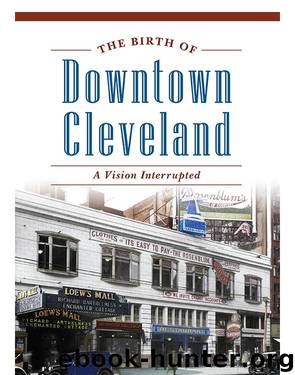The Birth of Downtown Cleveland by Dave Ford

Author:Dave Ford
Language: eng
Format: epub
Tags: A Vision Interrupted
Publisher: Arcadia Publishing Inc.
Published: 2018-03-04T16:00:00+00:00
Situated on Ninth Street between St. Clair Avenue and Oregon Avenue, Tidd the tailor, the Victory Restaurant and Polito’s Barbershop competed with the glitzy Euclid Avenue stores for customers. Schwartz.
The Courtland Hotel circa 1925 on the corner of Ontario Street and Lakeside Avenue. Schwartz.
The concept originating in the mid-1800s of living near or in the downtown area was abandoned after the turn of the century. The automobile and trolley allowed people to commute from the outskirts of town and get away from the dirt and grittiness of living next to small industry and the horse stalls of teamsters. By the early 1930s, even the opulent Victorian mansions on nearby Euclid Avenue were being used for commercial purposes such as car lots and small apartments. Many multipurpose buildings were erected to house stores on the ground floor and apartments above. The flow eastward of the middle class stemmed the tide of multi-unit residences in downtown Cleveland and ushered in the wrecking ball for most of them by 1930. With the decay of the older structures downtown, people began to move outward from the city center. Large modern apartment buildings were built on the edges of the downtown, further pulling residents outward. Suburban life took hold and did not let go until the gentrification of downtown almost one hundred years later.
In 1920, Cleveland was the fifth-largest city in the country, with a population of 796,841. That is an increase of 263,208 people (or 42 percent) from 560,633 in a mere ten years. Cleveland was feeling its oats and wanted to prove its status in the hierarchy of American cities. Cleveland flexed its urban muscles, powered by the heavy industry that filled the southern side of the city. The run-down or obsolete buildings were quickly marked for demolition and then torn down. There was a short time during the mid-1920s when lone structures would stand next to monumental newer buildings, further illustrating the inevitability of the time left for the pitiful few.
THE GREAT WAR
The Great War, World War I, concluded in Europe in 1918 with the help of American troops. The war proved to be a catalyst of change on the coming decade of the 1920s. Wars always advance technological change much quicker than during peacetime. Soldiers, after traveling across the world and seeing strange and exotic sights, were not content to stay at home and work on the farm or in small towns. These changes in attitudes along with more cosmopolitan ideas transferred back to the States and to Cleveland.
Cleveland flexed its industrial muscles, and its output grew from sixth to fifth in the nation during the war. Cleveland’s White Motor Corporation produced eighteen thousand trucks and ambulances for the war effort. The famous Thompson submachine gun was developed in Cleveland by Theodore Eickhoff for the Warner and Swasey Company. Cleveland also contributed the secretary of war, Newton D. Baker, a onetime mayor of the city. Advances in vehicles and transportation affected the downtown area by allowing for the concept of commuting to take hold.
Download
This site does not store any files on its server. We only index and link to content provided by other sites. Please contact the content providers to delete copyright contents if any and email us, we'll remove relevant links or contents immediately.
| Bridges | Cities |
| Houses & Hotels | Lighthouses |
| Monuments |
Shoot Sexy by Ryan Armbrust(17142)
Portrait Mastery in Black & White: Learn the Signature Style of a Legendary Photographer by Tim Kelly(16484)
Adobe Camera Raw For Digital Photographers Only by Rob Sheppard(16387)
Photographically Speaking: A Deeper Look at Creating Stronger Images (Eva Spring's Library) by David duChemin(16161)
Bombshells: Glamour Girls of a Lifetime by Sullivan Steve(13109)
Art Nude Photography Explained: How to Photograph and Understand Great Art Nude Images by Simon Walden(12348)
Perfect Rhythm by Jae(4621)
Pillow Thoughts by Courtney Peppernell(3397)
The Book of Joy by Dalai Lama(3218)
Good by S. Walden(2915)
The Pixar Touch by David A. Price(2740)
Fantastic Beasts: The Crimes of Grindelwald by J. K. Rowling(2543)
A Dictionary of Sociology by Unknown(2518)
Humans of New York by Brandon Stanton(2379)
Read This If You Want to Take Great Photographs by Carroll Henry(2303)
Stacked Decks by The Rotenberg Collection(2270)
On Photography by Susan Sontag(2131)
Photographic Guide to the Birds of Indonesia by Strange Morten;(2088)
Insomniac City by Bill Hayes(2084)
